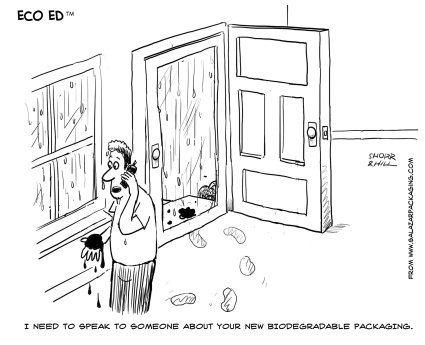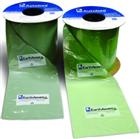
Whether you are talking about composting, oxo-degradability or biodegradability, the options are numerous, the facts confusing and the claims are very often downright misleading. The cartoon shown is appearing in the April issue of Packaging World magazine and it would be great if any degradable packaging product really worked as well or as quickly as the product Eco Ed is complaining about. The fact is that few do.
Composting
This option seems to be the favorite of food service companies because quite often their waste includes scrap food waste. It would be absolutely fantastic if that disposable plate, spoon, or clamshell style container could be composted along with the food waste it may contain and then the earth would be a big, happy and green place. Unfortunately the fine print on most “compostable” products is that it will only degrade or breakdown in a municipal or industrial compost facility.
So I went to www.findacomposter.com and typed in my home state of Illinois. I was pleased to see seven composting facilities listed but when I clicked for more information I found out they all do composting of yard waste, not the type of food and food service waste we need to be processed. Keep in mind there are people who buy these products who actually believe they will be able to process them in their back yard compost heap. All I can suggest is keep the house in the family and perhaps the grand kids will live long enough see these products degrade.
Oxo-Degradability
To many, this is the newest and greatest option since it relies on a chemical breakdown rather than a purely biological breakdown of the product. Add a special additive and the bag or plastic product it is added to will slowly degrade when exposed to air and light. This does present at least two problems because if you add too little of the additive, the breakdown takes longer than is desirable. Add too much of it and the product could possible degrade on the shelf before it even gets in the hands of the consumer.
If the additive truly does require air and light in order to degrade, I have been to a landfill and can verify there is an extreme shortage of both. So I am not quite sure how this is going to work effectively but I do agree this option deserves more time and consideration. I believe this will prove to be a tremendous option in time as the additives and processes are fine tuned.
Biodegradability
What I love about this option is that we are enlisting the help of nature to help us clean up the mess we created in nature. Micro organisms will break down a packaging product if we give them something to munch on. This could be cornstarch, potato starch or almost any other vegetable/green component that is edible. This too is a science that is being improved and perfected on an almost daily basis. Equally important, tests and standards are now available to make performance comparisons easier.
 I find this area of the plastics industry incredibly encouraging because they appear to be addressing many of the typical problems in the biodegradation process. For example, one of our favorite suppliers, Automated Packaging last year introduced their Earth Aware line of inflatable void fill products. Their product will degrade with or without the presence of oxygen. It is also stable enough that it will not begin degradation prematurely, or “on the shelf”. This is all really good news if you want the benefits of inflatable plastic void fill but need help getting over the guilt associated with use of a plastic product.
I find this area of the plastics industry incredibly encouraging because they appear to be addressing many of the typical problems in the biodegradation process. For example, one of our favorite suppliers, Automated Packaging last year introduced their Earth Aware line of inflatable void fill products. Their product will degrade with or without the presence of oxygen. It is also stable enough that it will not begin degradation prematurely, or “on the shelf”. This is all really good news if you want the benefits of inflatable plastic void fill but need help getting over the guilt associated with use of a plastic product.
Back to Eco Ed
As you can see my cartooning partner, Brad Shorr and I take some liberties when creating this series of cartoons. It is very unlikely a product will ever degrade that rapidly in an April rain storm, but it would be really great if it could happen in a landfill.


